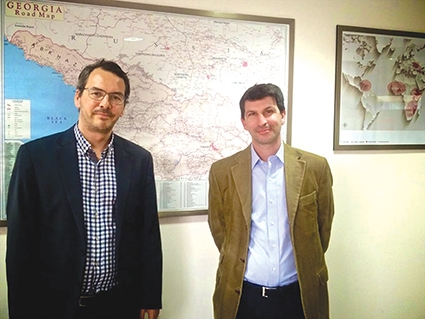ADA: Strengthening Georgia’s Agricultural Economy
Exclusive Interview
Numerous national governments and international organizations have set up development schemes to support civil society and democratization efforts in Georgia. Often, however, development happens in hidden areas not very visible to the majority of the population in the city. Austria, which ranks globally among the best countries for farming strategies and environmental protection, is working heavily with the Georgian public and the Georgian government to improve the efficiency and sustainability of forests, agricultural infrastructure, and crop farming strategies. We sat down with Gerhard Schaumberger, Head of Office at ADA Georgia, to pick his brain on the different strategies implemented in the area over the last years.
How does ADA operate in Georgia?
The administrative team here in the office is a small team of four, making it quite efficient. However, taking all the people into account with whom we work on the different projects, we would definitely reach a headcount of hundreds of people.
ADA supports numerous projects aimed at spurring agricultural development in Georgia. Is there a focus on a specific type of partner?
We work with an extremely diverse group entailing different kinds of partners. We work with government offices, ministries, Georgian NGOs, the UN, but also with private companies and funds. The effect is an assemblage of partners each focusing on a specific sector which will be agreed upon when the partnership is set up. In agreement with the Georgian government, the main sectors we are supporting in Georgia are agricultural reforms and local administration reforms.
The project sizes vary hugely between a support of €10,000 to around €5,000,000. Often, these funds are channeled together with different actors, such as the UN or the European Union. We have great experience working with Switzerland and Germany, as they are like-minded supporters.
In terms of development projects in Georgia, can you elaborate on the core area of ADA?
Our main focus is on agriculture. Around 70% of funds go towards agricultural projects, whereas 20-30% goes to government and civil society projects, such as the recent launch to spur decentralization, with the UNDP. The remaining projects deal with social infrastructure and services projects. We are also supporting many projects of other Austrian government institutions which cooperate with the Georgian authorities. One example is a project to prevent the radicalization of different social groups through sport in the Kakheti region. In the past, many efforts entailed humanitarian aid as well, especially during the 2008 and Chechen wars, where a close cooperation with the Georgian government was essential.
What projects and support schemes have been set up with Georgian NGOs?
We have multiple projects of considerable sizes, such as with the Georgian Farmer Association. They are doing a fantastic job in agricultural innovation and value chain management; for example, we could increase the cultivation of the so-called winter onion, which can be sold at times when the ordinary onion does not grow, ensuring a constant market supply of onions for better profit margins. Furthermore, we have a couple of projects supporting honey farmers and hazelnut producers, such as our first project generating organic hazelnuts. The hazelnut is the largest export produce of Georgia and globally ranks second after Turkey.
Besides projects in the cultivation of crops, are there any other projects dealing with issues such as deforestation or irrigation?
Thankfully, Georgia’s geographical situation with many mountains and glaciers solve many irrigation problems already. It doesn’t have the issues which flat countries such as Moldova or countries in dry areas encounter on a regular basis. Despite that, we have worked on small-scale projects to improve irrigation systems. For example, in the Kakheti region, many farmers could profit from these systems, especially in the summer periods. These issues can be attributed to climate change as well. The effects are clearly visible in Georgia. One farmer has placed over 40 kilometers of drip irrigation for a Japanese Persimmon cultivation. Without the drip irrigation system, his entire cultivation would be in a critical condition today.
In terms of forestry, there are many debates and discussions about it. Austria and Georgia have almost the same percentage of forest cover, at around 40%. There was the hope to be able to generate a strong forestry in Georgia, like that of Austria, which has an advanced and European-leading timber industry. However, this idea is not as prevalent anymore and the main focus is on forest protection as well as recreational use, such as for tourism. The problem with setting up a strong forestry is the strong competitiveness of other countries already very advanced in the industry. Looking just north of Georgia, we have Russia with thousands of kilometers of forests.
ADA supported the efforts in the forest industry with a couple of projects, one conducted by the World Bank, for example, and another with an NGO. Thankfully, new legislation strengthening the National Forest Association, helping to increase the leverage of forest protection. Furthermore, It is important to create awareness in the national educational system of the value of the forest in Georgia. Just last week, we had a competition and awarded young people for generating environmental awareness.
To also avoid illegal cutting, which often was used as a means of heating in isolated areas, many projects deal with the generation of biomass energy. The European Union has set up financial schemes to support such efforts, but it is very difficult to make them financially sustainable.
Are there projects in the energy sector in Georgia?
Georgia is doing a fantastic job to improve the sector. The Ministry has presented very ambitious plans and we Austrians can definitely associate in terms of hydroelectric power plants, as both countries have large amounts of water thanks to the glaciers. There are always certain negative aspects, but overall, we see high interest in hydroelectric energy, which can become essential, together with other alternative energy sources.
Benjamin Music











